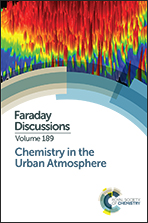Urban particulate matter pollution: a tale of five cities
Abstract
Five case studies (Athens and Paris in Europe, Pittsburgh and Los Angeles in the United States, and Mexico City in Central America) are used to gain insights into the changing levels, sources, and role of atmospheric chemical processes in air quality in large urban areas as they develop technologically. Fine particulate matter is the focus of our analysis. In all cases reductions of emissions by industrial and transportation sources have resulted in significant improvements in air quality during the last few decades. However, these changes have resulted in the increasing importance of secondary particulate matter (PM) which dominates over primary in most cases. At the same time, long range transport of secondary PM from sources located hundreds of kilometres from the cities is becoming a bigger contributor to the urban PM levels in all seasons. “Non-traditional” sources including cooking, and residential and agricultural biomass burning contribute an increasing fraction of the now reduced fine PM levels. Atmospheric chemistry is found to change the chemical signatures of a number of these sources relatively fast both during the day and night, complicating the corresponding source apportionment.
- This article is part of the themed collection: Chemistry in the Urban Atmosphere

 Please wait while we load your content...
Please wait while we load your content...